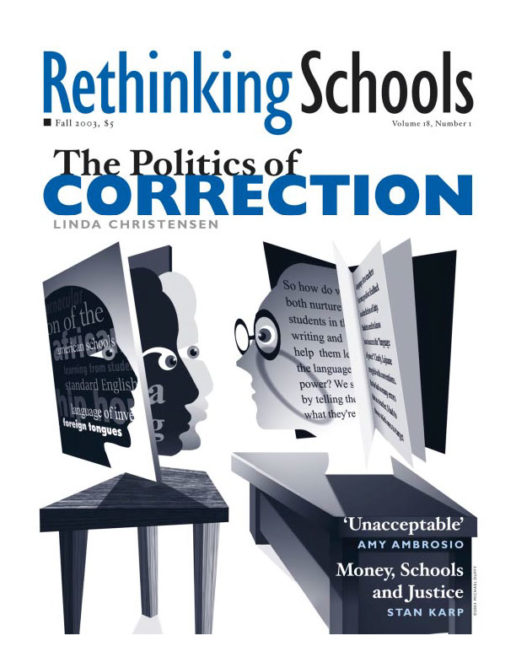Urban Students Tackle Research on Inequality
Illustrator: David McLimans

Over the 2002–2003 school year, we had the opportunity to teach a youth research course as part of a larger project examining issues of race, class, and educational opportunity. Directed by Dr. Michelle Fine at the City University of New York (CUNY) Graduate Center, the project involved educators and students from 13 suburban and urban districts in an exploration of issues related to academic “achievement gaps.” One part of this effort encouraged students to become active research participants.We taught a bi-weekly course where juniors and seniors from East Side Community High School in New York City examined issues of educational opportunity. Rather than planning the curriculum ahead of time, we worked with students to figure out what their questions were about these issues,and then spent the semester guiding them through a process of active, primary research that allowed them to discover their own answers. Along the way, we watched students choose topics that were both deeply personal and deeply political; we saw them design their own research process,deciding what methods to use,who they wanted to interview, and sites they wanted to visit. We helped them teach themselves how to do interviews, work in teams, and tackle difficult texts that related to their topic. The abridged article below is one example of their work.
— Janice Bloom and Lori Chajet
What You Thought We Didn’t Know
New York City educates 37 percent of New York State’s population but receives 33 percent of the state education budget.
Great Neck, N.Y., spends $17,640 dollars per student on education. New York City spends $9,623 dollars per student.
We are a group of seniors at New York City’s East Side Community High School who are examining the fiscal inequities among urban and suburban schools. We have been researching what a “sound, basic education” is as part of a project with graduate students from CUNY.
Article XI of the New York State Constitution says, “The legislature shall provide for the maintenance and support of the system of free common schools, wherein all the children of the state may be educated.” In the case of the Board of Education, Levittown Free School District v. Nyquist (1982) the court interpreted this to mean that all students be given the opportunity of a “sound basic education.”
East Side Community High School is a small urban school that ranges from grade seven to 12. Students are graded by using performance-based assessment instead of standardized tests; our graduation depends upon our portfolios of work — including essays, projects, research papers, and tests. We don’t just look at the dates and times in history or memorize math formulas. We look at the how and why as well. And that’s what got us interested in this project.
In comparison to other high schools in the city, East Side’s resources aren’t the greatest, but they aren’t the worst. The gym isn’t a “real” gym. The ceiling is so low that when one of us tries to make a jump shot, the basketball hits the ceiling. Our library is too small and our science labs are virtually nonexistent. We wondered why our school was so broke and we wondered if we are being cheated of an education. So we decided to take action.
Our research group met twice a week throughout the school year. We had discussions about the inequality of school funding. We did readings and conducted interviews with different people — students, principals, community activists, education professors, lawyers, and poli-ticians. We learned that school budgets are made up of local and state money — and that the local money comes mostly from property taxes. We also learned that the state doesn’t take into consideration how much money a local district already has — or what the needs of the students in that district are — when deciding how much each district will get. We conducted a survey with 150 students in our school and we learned that 91 percent of the students have no knowledge of how school funding occurs. However, 88 percent of the students believe that funding is a huge factor in their education and 75 percent believe their school does not receive a sufficient amount of funding.
We visited a range of schools from urban and suburban areas. We focused on three things: the diversity among the students, where “minorities” stand within their school, and the school’s resources. Walking down the halls of South Bronx High School — which is 88.8 percent Latino, 9.9 percent African American, and .6 percent white — we saw overcrowded classrooms, computer labs with outdated equipment, and lack of resources.
Walking through Mamaroneck High School — in an upper middle class suburb of New York City — we saw many computer labs with updated equipment, a college information center, two gyms, and two theaters. About 47 percent of South Bronx’s students are English Language Learners and 76 percent qualify for free lunch; in contrast, about two percent of Mamaroneck students are English Language Learners and three percent qualify for free lunch.
Not surprisingly, while Mamaro-neck’s 12th grade was almost the same size as its ninth grade, South Bronx’s ninth grade was almost four times as large as its 12th grade in the same year. While Mamaroneck offers 14 Advanced Placement (AP) classes, South Bronx used to offer two and currently offers none. While 33 percent of South Bronx’s graduates go on to a four-year college, nearly three-quarters of Mamaroneck’s students do.
After visiting numerous high schools, we realized that things are not the same everywhere. There are schools that have lots and lots of money and there are schools that have nearly no money at all. Zero, zilch, nada! Is this really a problem? Does money really affect a child’s ability to learn and receive a sound, basic education?
We’re not the only ones looking into this issue. In 1992, the Campaign for Fiscal Equity (CFE) went to court because they felt that kids in New York City schools were not getting the education that’s required by our state constitution — a “sound, basic education.” CFE argued that students needed skills in analyzing and solving problems, communicating, and working with others to do well in a working environment. To do this, they said, students need trained teachers, textbooks, classroom space, and other resources. And what do city schools need to get all this? That’s right folks: more money .
CFE succeeded in convincing the judge that New York City students weren’t getting a “sound basic education.” Justice DeGrasse agreed with CFE, saying that certified teachers, smaller classrooms, and adequate resources were important to get a good education. This would mean the state would have to fork over more money to provide all this. But New York didn’t want to do that, so Governor Pataki appealed the case.
Then an appellate court ruled in favor of the state’s unequal education system. The judge who wrote the appellate opinion, Justice Lerner, had the nerve to say that a “sound, basic education” can be received by the eighth grade. (And this is coming at a time when the State now wants students to pass Regents exams to graduate high school. Why take Regents then? If students can learn all they need to know in order to function as a productive citizen in the eighth grade, then what is the point of having students struggle through high school or even college?) The judges said that all we need to be able to do is vote, serve on a jury, and read those stupid little pamphlets that clutter up our mailboxes. That was a huge insult. How could this judge and the state have such low expectations for young people, especially those of color? The majority of students in urban settings are of color. They only expect us to take mind-numbing tests instead of questioning everything and really seeing how this world is.
A lot depends on how you define a “sound, basic education.” Because it’s such an important question, we have made that part of our research. We asked many people their opinions on what a sound, basic education is. Our principal, Mark Federman, said a sound, basic education prepares you for college. Liz Kruger, a New York state senator, says a sound, basic education should, include the three R’s: reading, writing, and arithmetic. She also says we should learn computer skills, critical thinking, analyzing things, and knowing how to do research. She added that music was very important to her in high school because through music she understood math.
A senior from Mamaroneck High School says a sound, basic education is “education of the world through study of human history to prepare young adults for the world of tomorrow.” A freshman at Hunter College in New York City said that schools should prepare you for college. She had a hard time in college because her school didn’t have enough resources to prepare her for college. So it seems that most people we asked think that a sound, basic education should provide students more learning than just how to vote and to serve on a jury.
What is the obligation of the government to educate its children? There are many arguments about whether money matters in terms of students succeeding. While it is true that students need to work hard and take advantage of opportunities, if a school does not have qualified teachers, up-to-date books, or working computers, students cannot be prepared for college, work, or life itself. Overcrowded schools, poor resources and inadequate facilities have a major impact on a student’s education. What happens when students enter college and don’t know how to research information on a paper that has been assigned to them? A Queens elementary student wrote, “We have no labs. We have very little science equipment. We run a hands-on science program, with the help of PA [parent association] donations.” This is horribly sad. What if the Parents Association does not have that kind of money? What happens when these students go to college and they don’t know what to do with a microscope?
There are many failing schools in New York City. There are not many failing schools in the suburbs. If city schools had more money, they could get better teachers to work with students who need help to succeed, and there wouldn’t be so many failing schools in the five boroughs of New York City.
Wait, but there’s hope for the students in the failing schools. President Bush passed the “No Child Left Behind” Act, which says that students who are attending failing schools have the opportunity to go to a school that isn’t considered a failing school. There’s only one problem with that: In the Bronx alone there are 25 schools that are considered failing. Where are the kids gonna go? How are all these students gonna be accommodated? These students won’t get a “sound, basic education.” Instead of just moving students from one school to the next, why not just improve the school they are already in? And once again, that means more money.
But we’re just a couple of minority students who attend school in New York City. What would we know about this? We only see this about every single day of our lives. We think we would know what it takes to get a good education. But what’s your definition?

